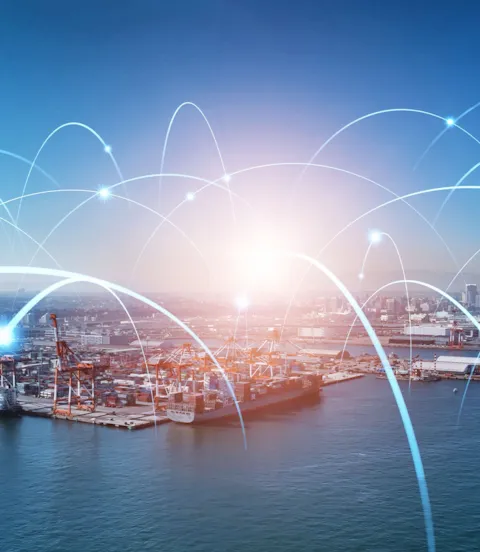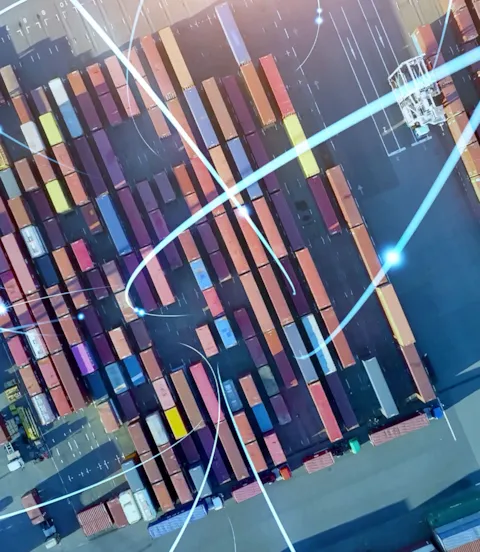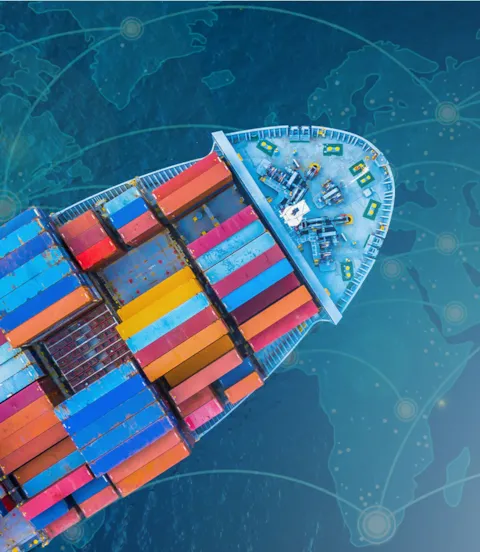Containership 2050: When the box becomes the customer
What could a sophisticated data- and analytics-driven supply chain in the container segment look like? Jan-Olaf Probst, Business Director – Containerships at DNV, shares a possible future of a fully digitalized and decarbonized market and what it will take to get there.
Let’s imagine that one afternoon in 2050, a young woman opens her front door. A couple of minutes earlier, she received an alert that her recent order was about to arrive. She steps out and watches an autonomous electric delivery vehicle pull up. She uses the fingerprint reader to confirm receipt of her parcel and heads back inside.

Digitalization changes the future supply infrastructure
Looking in detail, it’s the steps before the parcel arrives that really show how the industry has changed from today. The parcel was unloaded from a container at the local port that morning. The ship it came on sailed 100 nautical miles from a coastal town where the woman’s online purchase triggered a production order at the local fabrication plant. There the product was created, boxed and loaded into a container at a nearby harbour. The product’s journey from fabrication through to delivery at her home is recorded in a digital log, in addition to the materials that went into its construction.
By 2050, the outbound and inbound ports have become more like airports in the sophistication and speed with which they anticipate, prepare for, handle and dispatch containers. The key is how container boxes, largely ‘stupid’ in 2022, become ‘intelligent’ through the addition of microchips, sensors and transmitters.

How containers turn into an intelligent part of the logistics chain
Even after many decades of progress in standards development, expertise and digital technologies for containers, they are still regarded today simply as cargo. But we are also starting to see how digital technologies will enable a philosophical switch.
In 2050, the box is now a customer, an intelligent and interconnected part of an integrated logistics system, with containers, ships, trucks and trains all communicating with each other through enabling technologies like digital sensors, data analytics, machine learning and artificial intelligence.
In this vision of 2050, the box tells stakeholders along the logistics chain what it contains, whether the cargo is hazardous, where it is coming from and going to, and if it will need repacking at the arrival port because there are multiple customers for its contents. Computer modelling will use location information from the vessel to precisely schedule port operations. The ship arrives precisely on time, unloading and loading begins ten minutes later, and the vessel leaves within a tightly scheduled window.

Reducing waiting times in ports must become a reality
Reducing waiting times in ports will be an important part of decarbonizing containership operations, boosting the availability of vessels, further enabling energy-efficiency measures such as slow steaming, and optimizing port throughput. We must make this vision a reality. Containerized transport is forecast to grow 80% by 2050, which means transport efficiency must improve significantly in terms of both decarbonization and business economics.
It is entirely possible that when the young woman receives her parcel in 2050, the packaging will link back to a digital log to confirm that the product is zero-carbon across its value chain – from raw material to doorstep. The transportation elements are emissions-free because, this being mid-century, shipping has already decarbonized in line with progressively tighter emissions reduction targets agreed at the International Maritime Organization (IMO).

Alternative fuel options that facilitate zero-carbon deliveries
DNV’s classification and advisory work and tracking of market trends shows that containership lines are already ordering vessels whose low operating emissions will already put them ahead of the initial IMO greenhouse gas reduction ambitions today.
For deep-sea shipping, where combustion engines are the most suitable type, our research such as the Maritime Forecast to 2050 indicates synthetic methanol and ammonia as feasible options for large containerships. Synthetic LNG will be an important transition fuel over the coming decades, but its phase-out may have already begun by 2050. Smaller vessels have trended more towards fuel cells or battery-electric where possible.
There will still be big containerships – 24,000 TEU, 15,000 TEU and some at 10,000 TEU – on the long-distance Asia-Pacific, India, Europe, US, Africa and South American trade routes. The age of the Small Feeder, Feeder, Feedermax, Panamax, Post Panamax, New Panamax and Ultra Large Container Vessel categories will not be over anytime soon.

The market for small container vessels will grow
However, we expect to see an increase in smaller 1,000 TEU to 4,000 TEU vessels. Drawing on the lessons from the pilot projects of today, like DNV’s ReVolt concept, these fully automated and zero-emission vessels enable ‘door-to-door’ distribution of locally produced and feeder cargo from longer-distance routes.
Making more use of smaller vessels will remove cargo from roads, a goal of many urban areas seeking to reduce traffic congestion and air pollution, but will also require more ports along coastlines. Cities located on waterfronts will have strategic advantages as container traffic shifts more to the sea.

Improved data quality and sophisticated analytics facilitate increasing efficiency
In summary, more and better-quality data, and increasingly sophisticated analytics, will give containership owners and operators richer, more accurate and timelier insights. This will enable them to maximize operational efficiency and profitability, schedule inspection, repair and maintenance, reduce emissions, plan vessel replacement or refits, and optimize their choice of vessel size, fuels, fuel systems, converters and layout.
The events of the last several years have added impetus to policymakers’ interest in localization of production and supply chains. While 2050 seems a distant horizon, the implications of the intelligent container box challenges both the maritime industry and beyond to adopt long-term thinking on infrastructure, incentives and collaboration to enable and maximize the potential economic, environmental and social benefits of a future vision where the box is the customer.
- metamorworks - stock.adobe.com
- Shutterstock / metamorworks
- Kalyakan - stock.adobe.com